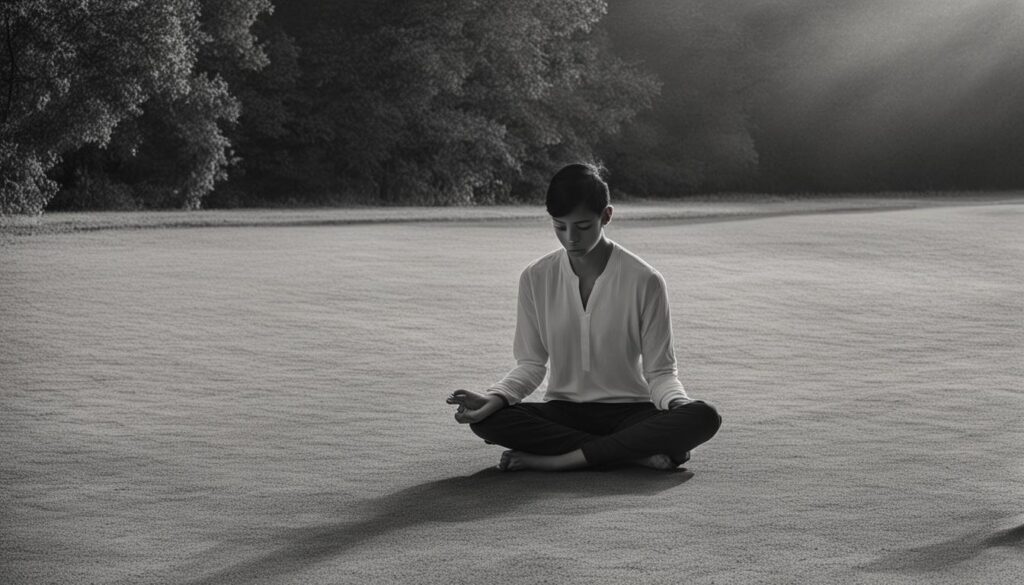Are you looking to take your meditation practice to the next level? Discover the power of invigorating meditation positions that can enhance your practice and elevate your mindfulness journey. By incorporating these positions into your daily routine, you can transform your meditation experience and unlock new levels of focus, wisdom, connection, energy, and heart-centered awareness.
Key Takeaways:
- Explore 5 invigorating meditation positions to enhance your practice and elevate your mindfulness journey.
- Discover the power of mudras, hand gestures that activate specific parts of the brain and energy circuits.
- Dhyana Mudra brings focus, stability, and self-awareness.
- Jnana Mudra promotes wisdom, relaxation, and clarity.
- Bhūmisparśa Mudra connects with purity, inner strength, and clarity.
- Prana Mudra activates energy and cleanses the aura.
- Anjali Mudra invites heart centering and unconditional love.
The Power of Mudras in Meditation
When it comes to enhancing your meditation practice, mudras can be a powerful tool. These hand gestures have been utilized in Hinduist and Buddhist traditions for centuries, and they offer a multitude of benefits. By activating specific parts of the brain and energy circuits within the body, mudras can help you achieve different meditation states and deepen your practice.
There are over 100 mudras in existence, each with its own unique purpose. In this article, we will focus on five mudras that can enrich your daily meditation routine. By incorporating these mudras into your practice, you can amplify the effects of meditation and experience greater mindfulness.
Different Meditation States and Activation of Brain and Energy Circuits
Each mudra has its own specific qualities and benefits. For example, the Dhyana Mudra, also known as the samadhi mudra, brings focus, stability, and helps center the mind. It activates the brain regions associated with concentration and self-awareness, allowing you to dive deeper into your meditation practice.
On the other hand, the Jnana Mudra is known as the wisdom mudra. By bringing the thumb and index finger together, this mudra helps open up to divine energy, promote relaxation, and foster clarity and serenity. It activates the brain circuits related to receptiveness and wisdom, allowing for a deeper connection to your inner self.
An Overview of the Five Mudras
- Dhyana Mudra: Focus and stability
- Jnana Mudra: Wisdom and relaxation
- Bhūmisparśa Mudra: Connection with purity and inner strength
- Prana Mudra: Activation of energy and cleansing the aura
- Anjali Mudra: Salutation and heart centering
By practicing these mudras regularly, you can enhance your meditation states, activate specific areas of the brain, and stimulate the energy circuits within your body. As a result, you’ll experience a deeper level of mindfulness and reap the benefits of a consistent meditation practice.
Dhyana Mudra: The Path to Focus and Stability
In our exploration of mudras for meditation, we come to the Dhyana Mudra, also known as the samadhi mudra. This hand gesture holds significant meaning and has been utilized by practitioners seeking focus, stability, and self-awareness in their meditation practice.
To perform the Dhyana Mudra, sit in a comfortable position and place both hands in your lap, palms facing upwards. Gently touch your thumbs together, allowing the rest of your fingers to rest naturally. This mudra symbolizes the unity of the individual with the universal consciousness, bringing balance and grounding to the mind and body.
The Dhyana Mudra is particularly beneficial for those seeking to deepen their meditation practice. By incorporating this hand gesture into your meditation routine, you can enhance your ability to concentrate, quiet the mind, and achieve a state of tranquility. The thumb-to-thumb connection serves as a reminder to stay present and focused, while the palms facing upwards invite a sense of openness and receptiveness to the energy around you.
Benefits of Dhyana Mudra:
- Enhanced focus and concentration
- Increased stability and grounding
- Heightened self-awareness
- Deeper connection with the present moment
By incorporating the Dhyana Mudra into your meditation practice, you can cultivate a sense of inner calm, sharpen your focus, and deepen your overall mindfulness journey. It serves as a powerful tool for those seeking to find stability, grounding, and self-awareness in the midst of life’s challenges.
| Position | Description |
|---|---|
| Dhyana Mudra | Both hands placed in the lap, palms facing upwards, thumbs gently touching |
| Benefits | – Enhanced focus and concentration – Increased stability and grounding – Heightened self-awareness – Deeper connection with the present moment |
“The Dhyana Mudra brings focus, stability, and helps center the mind. It also increases self-awareness and grounding.”
Jnana Mudra: Opening up to Wisdom and Relaxation
Experience the transformative power of Jnana Mudra, also known as the wisdom mudra, during your meditation practice. This hand gesture, commonly used in yogic traditions, offers a pathway to enhanced receptiveness and deep relaxation. By incorporating Jnana Mudra into your routine, you can tap into your inner wisdom and achieve a state of calm and clarity.
To perform Jnana Mudra, bring the tip of your thumb and index finger together while keeping the other fingers straight. This simple yet powerful hand position creates a connection between the thumb, representing universal consciousness, and the index finger, symbolizing individual consciousness. This union brings harmony to the mind and body, allowing you to release stress and embrace tranquility.
“The wisdom mudra, Jnana Mudra, invites you to let go of distractions and open yourself to the profound wisdom that resides within you.”
As you hold Jnana Mudra, focus your attention on your breath and allow yourself to let go of any thoughts or worries. This mudra encourages a deep sense of relaxation and receptiveness, helping you access your innate wisdom and intuition. It is especially beneficial when you find yourself overwhelmed or in need of clarity.
Benefits of Jnana Mudra:
- Promotes relaxation and stress relief
- Increases receptiveness and intuition
- Aids in mental clarity and focus
- Enhances self-reflection and introspection
- Supports the cultivation of inner wisdom
Unlock the potential of your meditation practice with Jnana Mudra. Embrace the wisdom within you and experience a profound sense of relaxation and receptiveness. Allow this hand gesture to guide you on a journey of self-discovery and spiritual growth.

Bhūmisparśa Mudra: Connecting with Purity and Inner Strength
When it comes to meditation, the Bhūmisparśa Mudra is a powerful hand gesture that holds deep significance. This mudra is associated with Buddha when he reached enlightenment, making it a symbol of spiritual awakening and transformation. By understanding the meaning and practice of the Bhūmisparśa Mudra, you can tap into its energy to connect with purity and inner strength on your mindfulness journey.
The Bhūmisparśa Mudra involves placing the left hand in the lap with the palm facing up, and the right hand touching the Earth. This gesture not only represents grounding and stability but also symbolizes the moment when Buddha called upon the Earth as his witness to vanquish the temptations and achieve enlightenment.
By incorporating the Bhūmisparśa Mudra into your meditation practice, you invite a sense of connection and reverence. This mudra helps you cultivate purity, inner strength, and fearlessness. It serves as a reminder of your own capacity for transformation and deepens your connection to the spiritual path.
| Benefits of Bhūmisparśa Mudra: |
|---|
| 1. Connection to Buddha and his teachings |
| 2. Cultivation of purity and inner strength |
| 3. Grounding and stability in your practice |
| 4. Development of fearlessness and clarity |
As you enter into the Bhūmisparśa Mudra during meditation, take a moment to reflect on its deeper meaning and the qualities it represents. Embrace the connection to Buddha, tap into your inner reservoir of strength, and let the purity of your intentions guide your practice. With each breath, feel the Earth supporting you and empowering you on your journey towards self-discovery.


Prana Mudra: Activating Energy and Cleansing the Aura
Prana Mudra is a powerful hand gesture that can help you activate dormant energy within your body and cleanse your aura. By connecting the thumb with the ring and little fingers while keeping the other two fingers straight, you create a circuit that allows the flow of energy throughout your system. This mudra is particularly beneficial for those who are experiencing exhaustion, blocked energy, or a lack of willpower.
When you practice Prana Mudra, you are harnessing the vital life force energy known as prana. This energy is responsible for your vitality, stamina, and overall well-being. By activating and balancing the flow of prana, you can experience increased energy levels, improved focus, and a renewed sense of vigor.
“Prana is the breath of life, the vital energy that sustains us. With Prana Mudra, you can tap into this energy and cleanse your aura, allowing for a greater sense of balance and harmony.” – Yogi Master
Benefits of Prana Mudra
- Activate dormant energy within the body
- Cleanse and purify the aura
- Boost energy levels and combat exhaustion
- Improve focus and concentration
- Enhance willpower and motivation
Prana Mudra can be practiced during meditation, yoga, or at any time when you need an energy boost. Take a few moments each day to connect with this powerful mudra and experience the revitalizing effects it can have on your mind, body, and spirit.
| Mudra | Energy Activation | Aura Cleansing |
|---|---|---|
| Prana Mudra | ✓ | ✓ |
| Dhyana Mudra | ||
| Jnana Mudra | ||
| Bhūmisparśa Mudra | ||
| Anjali Mudra |
Anjali Mudra: Salutation and Heart Centering
In your meditation practice, the Anjali Mudra, also known as the mudra of prayer, is a powerful hand position you can incorporate to deepen your connection with yourself and the divine presence. This mudra involves pressing your palms together in front of your heart center, creating a sense of reverence and gratitude.
The Anjali Mudra is a beautiful way to begin your meditation practice, as it helps to calm the mind and bring your attention to the present moment. By honoring the divinity within yourself, you can cultivate a deep sense of self-love and acceptance. This mudra also opens the heart unconditionally, allowing for the experience of unconditional love and compassion towards yourself and others.
“The Anjali Mudra is a beautiful way to express gratitude and connect with the divine energy present in all of creation.”
Through the Anjali Mudra, you can create a sacred space within yourself, where you can tap into your inner strength and wisdom. It promotes a sense of unity with the soul and allows you to align with your true purpose and values. The Anjali Mudra can be practiced at any time during the day, not just during meditation, to bring about a sense of peace and harmony in your life.
Benefits of Anjali Mudra:
- Calms the mind and reduces stress and anxiety
- Opens the heart center and promotes feelings of love and compassion
- Connects you with the divine energy present in all of creation
- Enhances your sense of self-awareness and self-acceptance
- Aligns you with your true purpose and values
- Brings about a sense of peace and harmony
| Anjali Mudra | Keywords |
|---|---|
| Hand Position | Pressing palms together in front of the heart center |
| Benefits | Calms the mind, opens the heart, connects with the divine energy |
| Experience | Unconditional love, unity with the soul, peace and harmony |
Conclusion
As you conclude your mindfulness journey, remember the power of incorporating different meditation positions into your practice. These positions, enhanced by the art of mudras, can truly transform your meditation experience.
Choose the Dhyana Mudra to focus and stabilize your mind, or embrace the Jnana Mudra to open up to wisdom and relaxation. If you seek connection and inner strength, the Bhūmisparśa Mudra is for you. Alternatively, activate your energy and cleanse your aura with the Prana Mudra. Finally, embrace the Anjali Mudra to center your heart and expand your presence.
By incorporating these invigorating meditation positions into your practice, you will discover a new level of mindfulness and presence. Begin your journey today and unlock the transformative power of meditation.
FAQ
What are mudras?
Mudras are hand gestures that have been used in Hinduist and Buddhist traditions for centuries. They activate specific parts of the brain and energy circuits within the body, allowing for different meditation states and benefits.
How many mudras are there?
There are over 100 mudras in existence, but in this article, we will focus on five that can enrich your daily meditation practice.
What is Dhyana Mudra?
Dhyana Mudra, also known as the samadhi mudra, is a widely used hand gesture in meditation. It involves placing both hands in the lap with palms facing upwards and thumbs gently touching.
What are the benefits of Dhyana Mudra?
Dhyana Mudra brings focus, stability, and helps center the mind. It also increases self-awareness and grounding.
What is Jnana Mudra?
Jnana Mudra is a hand position commonly used in yogic traditions. It involves bringing the tip of the thumb and index finger together, while keeping the other fingers straight.
What are the benefits of Jnana Mudra?
Jnana Mudra helps open up to divine energy, increase receptiveness, and promote relaxation. It brings clarity, serenity, and wisdom to the practitioner.
What is Bhūmisparśa Mudra?
Bhūmisparśa Mudra is the mudra associated with Buddha when he reached enlightenment. It involves placing the left hand in the lap with the palm facing up, and the right hand touching the Earth.
What are the benefits of Bhūmisparśa Mudra?
Bhūmisparśa Mudra connects the practitioner to Buddha and helps in reaching states of purity, inner strength, stability, fearlessness, and clarity.
What is Prana Mudra?
Prana Mudra is a hand gesture that is highly energizing. It involves connecting the thumb with the ring and little fingers, while keeping the other two fingers straight.
What are the benefits of Prana Mudra?
Prana Mudra is said to activate dormant energy within the body and cleanse the aura. It is beneficial for overcoming exhaustion, blocked energy, and lack of willpower.
What is Anjali Mudra?
Anjali Mudra, also known as the mudra of prayer, is a hand position that involves pressing the palms together in front of the heart center.
What are the benefits of Anjali Mudra?
Anjali Mudra calms the mind, opens the heart unconditionally, and expands presence. It promotes a sense of connection to the soul.
How can these meditation positions enhance my practice?
These five invigorating meditation positions, through the power of mudras, can enhance your meditation practice and elevate your mindfulness journey.




